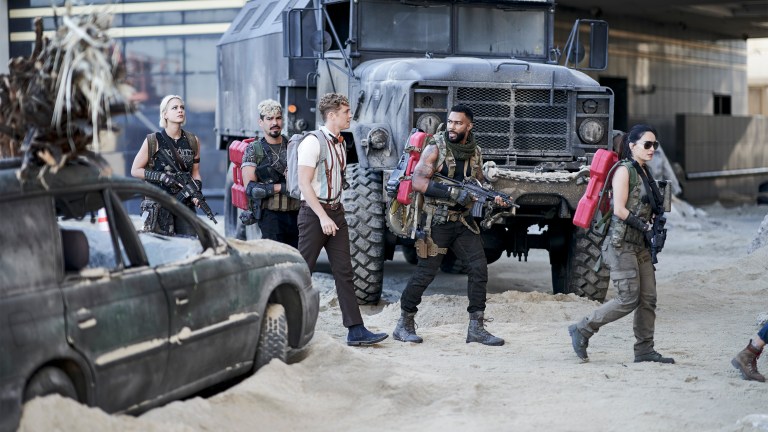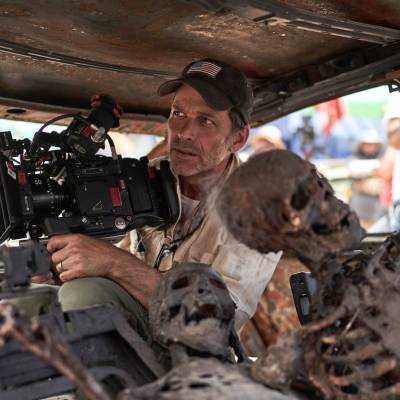How Zack Snyder’s Army of the Dead Expands on Dawn of the Dead
Zack Snyder returns to his zombie roots with Army of the Dead, referencing and building on ideas from Dawn of the Dead.

This Army of the Dead article contains spoilers.
The premise of Army of the Dead was originally intended for a Dawn of the Dead sequel. No, really. Director Zack Snyder is not shy about this point, mentioning to the press, including us, that he’s virtually had this concept in the back of his mind since time immemorial.
“Just exploring Dawn, in doing that movie and taking it apart [was exciting],” Snyder recently told Den of Geek. And while the idea of doing a direct sequel to his 2004 remake of the George A. Romero classic fizzled in the years after Snyder’s debut picture, the premise of a heist movie where the heroes have to break into an abandoned Las Vegas hotel to steal the proverbial jackpot has been a Snyder pitch “for forever.”
Now that Army of the Dead is finally here, thanks to Snyder partnering with Netflix, it is very much its own movie. Nonetheless, it is also happy to reference other cinema touchstones more than any other film in Snyder’s filmography. This includes winks to An American Werewolf in London, nods to Aliens, and most intriguingly overt expansions on what Snyder did in the Dawn of the Dead remake. Thematically, it even arguably feels like Zack is coming home.
This is obvious during the opening credits of the film, which may very well be the movie’s highlight. With Las Vegas under siege by the undead, we get a wonderful sequence of everything going to hell. Some might mistakenly feel it’s apiece with another 2000s zombie movie classic, Zombieland, which showed via slow motion vignette how zombies took over the world. However, Army of the Dead more overtly homages Snyder’s own Dawn of the Dead and then builds from that foundation.
The first major wink and nudge comes from the song choice. While Snyder elects to use an old standby for any movie set in Sin City, “Viva Las Vegas,” it is not Elvis Presley’s iconic rendition. Instead, we’re listening to Richard Cheese and Allison Crowe offer their own modern vocal stylings on the classic.
Cheese, the face of an intentionally comedic lounge act, has spent decades offering swinging covers to traditionally un-swinging tunes. That memorably includes his jazzy rendition of Disturbed’s “Get Down with the Sickness,” a heavy metal song with nihilistic implications. Cheese’s cover came to mainstream prominence, too, thanks to Snyder’s Dawn of the Dead.
In that 2004 film, we hear Cheese singing, “Get ready to die!” with maximum joyfulness as the last survivors of a zombie apocalypse find a bizarre definition for their “new normal” inside of a shopping mall with hordes of the undead outside.
For Army of the Dead, Snyder asked Cheese and Crowe to specifically cover Presley’s “Viva Las Vegas,” a song that was always meant to be a lounge act. However, the new version has added menace in 2021 since it’s now recorded with a self-aware detachment about the horrible images we are witnessing: zombie strippers murdering their customer in the bathtub; a paratrooper descending into a flesh-hungry mob ready to devour him whole; Vegas’ mini-Eiffel Tower crushing a poor old Zombie Elvis impersonator—killing him all over again.
The Army of the Dead opener also tells a grim story about how society both descends and stays the same. Unlike Zombieland, we follow a wordless narrative in the opening credits as a mercenary we later learn is Scott Ward (Dave Bautista) goes on a mission to save the Secretary of Defense. In the end, he gets the prized asset out, but the little girl his team also stumbles upon ends up crushed by the makeshift wall the U.S. government is forming around the city: a literal body in the foundation of this new world (which, by the by, alludes to a line of dialogue in Watchmen).
The opening credits of Dawn of the Dead (2004) actually use a sparing amount of original footage shot for that movie. Much of the imagery we see is from recordings of real moments of social unrest and war, which feeds into the frequent original Romero subtext that the living are already zombies. The more things change—be that by zombie virus or otherwise—the more they stay the same. Army of the Dead takes this further. Snyder has the budget this time to film an entire sequence of a world upended and carrying on. Hence showing how the U.S. government is able to prevent a global zombie apocalypse (for now) by walling up Vegas.
Afterward, the government now has a refugee crisis with detainment camps located all around the ruins of an American city, and in the movie’s universe a simpleton is still president, ordering a nuclear strike on the town on the Fourth of July because it’d be “really cool.” Years after zombies destroyed the town, guys like Scott Ward are also still flipping burger—or getting him and his friends killed while doing the bidding of shady wealthy elites like Bly Tanaka (Hiroyuki Sanada).
The opening sequence and whole first act of Army of the Dead builds on the idea of Dawn of the Dead, which suggests we were doomed to this disastrous fate even without zombie bites. But Army of the Dead uses world-building to expand on this concept in visceral and sometimes unique ways. Consider that in 2004, the Dawn remake was only the second zombie movie to have “fast zombies” after Danny Boyle’s 28 Days Later from two years earlier. Dawn then went a step further by introducing a… zombie baby.
In Dawn of the Dead ’04, Andre (Mekhi Phifer) and Luda (Inna Korobkina) are about to be parents when the very pregnant Luda is scratched by a zombie. Andre hides this fact from the rest of the survivors in the mall until his eventually zombified wife gives birth to an undead babe. The concept is never carried further than the crib since the other characters wind up killing the zombie baby as soon as it opens its dead eyes.
Army of the Dead winds up building off of that idea in alternately interesting and disappointing ways. Once again a zombie baby figures heavily into the plot, with a zombified woman pregnant with another zombie male’s child. Eventually, the zombie mother-to-be is beheaded and her child, still barely in utero, dies in her severed corpse.
Once again we are denied a full exploration of what a zombie baby would mean in this world, and if it could grow or develop, which is a bit disappointing. But by implication of being conceived by two zombie parents, Snyder is clearly attempting to build on the idea of what a zombie can be.
“I think the conversation I was starting to have with myself is: What will people allow in this genre of film?” Snyder told us.
So, what will people allow zombies to be? More than any non-comedy film before it, Army of the Dead leans into the idea that zombies can grow, learn, and essentially evolve into a new society. As another character in Snyder’s movie says, Las Vegas isn’t their prison; it’s their kingdom. One in which living humans barter for safe passage by offering literal sacrifices to the “alpha” zombies who’ve built a society.
It is the original zombie alpha who’s become a king (or “god” with his nickname of Zeus) in this world. And unlike the human characters in Army of the Dead, Zeus and his fellow alphas are immune from deceiving, backstabbing, or betraying each other. Snyder riffs on the Aliens line that they aren’t “fucking each other over for a goddamn percentage,” which is more or less said about his zombies here. But he’s also expanding on how far you can push zombies on screen.
In his first zombie movie, Snyder remade a Romero classic from 1978. But Romero’s later zombie movies, including Day of the Dead (1985) and Land of the Dead (2005), toyed with the idea of zombies growing more sentient and going their own way. Bub the Zombie in Day learned loyalty to human protectors and how to use a gun. “Big Daddy” in Land learned how to lead an exodus of pissed off shamblers against humans. But that was still working on allegorical terms about income inequality, and inequality between nations.
With Army of the Dead, Snyder goes much farther than the genre has before by imagining zombies building their own society and hierarchy. For arguably the first time since a baby zombie opened its eyes in Snyder’s Dawn of the Dead, these walkers are growing up.

